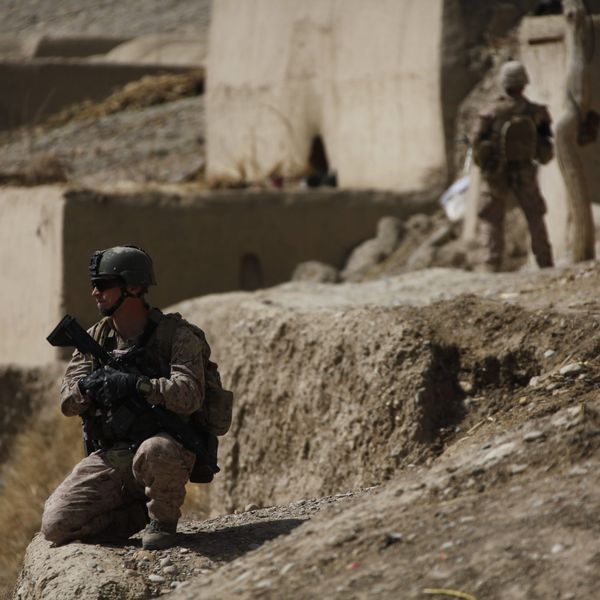Two senior Democratic senators this week renewed calls on the White House to rein in targeted killings through airstrikes, which frequently involve armed drones. Vermont’s Patrick Leahy and Dick Durbin of Illinois issued a letter to President Biden that essentially urged the administration to adopt more disciplined oversight of a program that has operated with impunity for almost two decades.
While well intentioned, the senators’ letter has an almost pro forma quality to it, especially when considering how Durbin himself has led congressional inquiries on such targeted killings for many years. The most recent botched drone strike in Kabul, highlighted in the letter, has prompted another likely fruitless series of pleas of restraint for the White House, which so far has shown little inclination for meaningful reform of the drone program.
The Biden administration is reportedly reviewing drone operations with an eye toward curtailing their use. But the time for half measures has passed, as the carnage in Kabul shows. President Biden should declare a moratorium on drone strikes if he is indeed serious about stopping the killing of innocent civilians.
Drones have long been a primary weapon in America’s counterterrorism air war, launching hundreds of missile attacks in multiple countries since 2002. Pakistan in Yemen in particular have endured sustained U.S. drone campaigns and offer a picture of the civilian casualty rate associated with drone warfare.
For Pakistan, tallies from the New America Foundation estimate that 414 drone strikes have killed up to 303 civilians. A project by the Bureau of Investigative Journalism examined drone strikes and Yemen, estimating that up to 225 civilians have died in 336 confirmed strikes. These figures are likely low in terms of number of actual drone strikes and civilian deaths, since the data come mainly from public observations in the absence of transparent government statistics. But even these conservative estimates suggest that on average at least one innocent civilian is perishing for every two drone strikes launched, if not more.
The steadily increasing civilian death toll from drone strikes poses much the same governance dilemma for President Biden that multiple U.S. governors have faced in recent decades regarding executions for death row inmates. Research and advocacy organizations like the Innocence Project have consistently shown how the death penalty process systematically condemns wrongly convicted people to die. Death row exonerations since 1973 total 185 according to the Death Penalty Information Center, which estimates that nearly four wrongly convicted people leave death row each year. Like drones, capital punishment condemns innocents to death as a regular feature of its functioning, in addition to killing its intended targets.
The blatant injustice of innocent people going to their deaths because of a flawed system has led multiple governors to issue moratoriums on executions in states exercising capital punishment. Oregon, California, and Pennsylvania are all currently under a moratorium on executions imposed by their governors. California Gov. Gavin Newsom articulated the moral problem perfectly in announcing his state’s moratorium in 2019: “Premeditated, state-sponsored executions… I cannot sign off on executing hundreds and hundreds of human beings, knowing among them are people who are innocent.”
Newsom’s characterization of California’s death penalty system as premediated, state-sponsored executions killing innocents aptly describes the U.S. drone program as well. This of course has always been true for the drone program, and others have previously called for ceasing drone strikes. But several factors now make the case for freezing drones strikes more compelling than in previous years.
The innocent deaths in Kabul in August came months after the Biden administration began rethinking drone killings. In March, the White House imposed limits on drone strikes and began considering new rules for their use. But events on the ground in Somalia and Afghanistan prompted the administration to unleash fresh drone assaults nonetheless, with predictable results for civilian casualties. Even a White House seemingly wary of drones and eager to end wars winds up killing civilians, just like the past administrations whose drone programs have drawn credible allegations of human rights violations.
Meanwhile, the Biden administration is taking much pride in its efforts to end forever wars. But America remains involved in war as long as U.S. bombs systematically fall in various countries around the world, regardless of whether ground troops are present or not. Withdrawing forces is not the same as ending wars, a fact that the Biden administration surely appreciates to some degree. Drone programs going forward in any given country will tend to have the same negative taint and problematic effects as lingering troops contingents in places like Iraq and Syria. A military presence from over the horizon is still a military presence breeding violence and resentment.
The fundamental problem with drones is not decision-making or policies surrounding their use. The problem is the weapon itself. Drones, for all their supposed precision and intelligence capabilities, seem to perform hardly better than cruise missiles or warplanes in terms of mitigating civilian casualties. But drones, unlike cruise missiles and warplanes, are much easier and cheaper to launch, meaning more strikes and greater civilian casualties. The logistical constraints of conventional weapons help limit their use and thus curb unintended consequences.
No administration is likely to abandon airstrikes altogether as a military tool in fighting terrorism and confronting other threats. But drones should be set aside as a weapon that can be used in good conscience by states claiming to adhere to principled use of armed force. Drones are similar in that way to landmines, a weapon whose use is virtually certain to kill and maim innocents regardless of precautions taken. Sadly, the United States is one of the few countries still clinging to the use of landmines when most nations have shunned the weapons. Now Washington is poised to do the same with drones, perpetrating their use even as public revulsion rises with civilian body counts.
The United States has led the way in drone warfare but now must move first to abandon the weapons and encourage others to do the same. Questions of legality and efficacy have long dogged the drone program as civilian casualties mounted. The program’s great secrecy cannot hide the devastating public toll, which will only increase so long as drones keep firing rockets. A lengthy policy review, while needed, will not fundamentally change what is already in plain sight. Armed drones kill civilians virtually every time they are used, so they should either be grounded or used for surveillance purposes only.
















